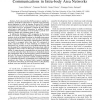901 search results - page 172 / 181 » Minimum power configuration in wireless sensor networks |
WONS
2012
IEEE
12 years 3 months ago
2012
IEEE
Abstract— Body area networks (BANs) promise to enable revolutionary biomedical applications by wirelessly interconnecting devices implanted or worn by humans. However, BAN wirele...
PERCOM
2005
ACM
14 years 7 months ago
2005
ACM
Different opportunistic routing protocols have been proposed recently for routing in sensor networks. These protocols exploit the redundancy among nodes by using a node that is av...
MASS
2010
13 years 5 months ago
2010
Wireless sensor networks typically conserve energy by following a periodic wakeup-sleep schedule: nodes minimize idle time and spend most of their time in a low power sleep state. ...
EWSN
2006
Springer
13 years 11 months ago
2006
Springer
The wide availability of radio signal strength attenuation information on wireless radios has received considerable attention as a convenient means of deriving positioning informat...
BSN
2011
IEEE
12 years 7 months ago
2011
IEEE
—Wireless neural recording systems are subject to stringent power consumption constraints to support long-term recordings and to allow for implantation inside the brain. In this ...

